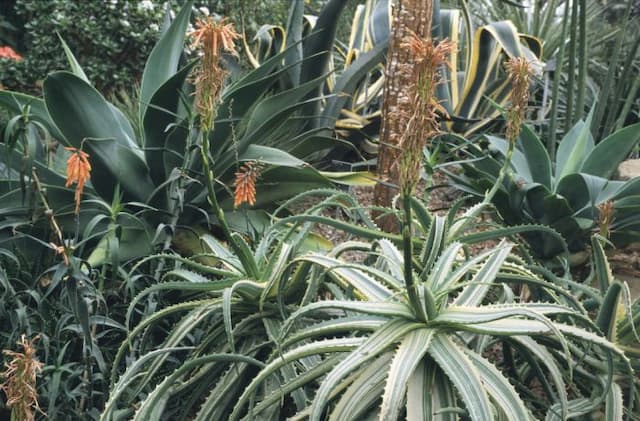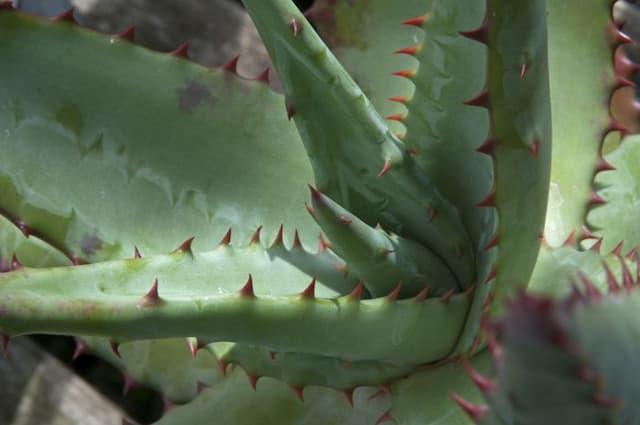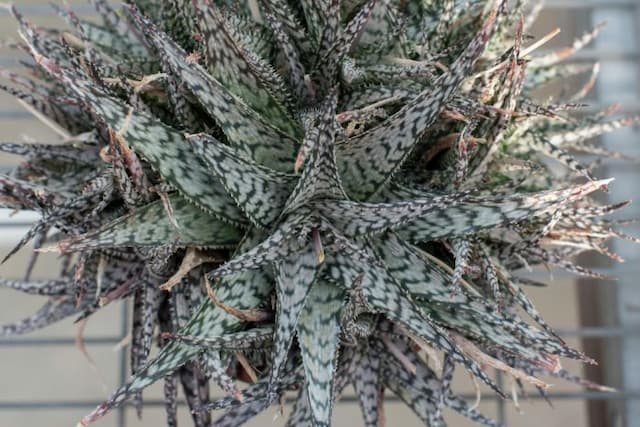Red Hot Poker Kniphofia northiae

ABOUT
Kniphofia northiae, commonly known as Red Hot Poker, presents a striking appearance with bold and vibrant features. The plant forms a clump of grass-like, arching leaves that are a rich green color and exhibit a lustrous sheen. They envelop the base of the plant with their fountain-like presence, creating a dense tuft of foliage. The most distinctive characteristic of the Red Hot Poker is its flower spikes. These emerge above the foliage on sturdy stems, bearing densely packed clusters of tubular flowers that are often fiery in appearance. The blossoms range in color, with warm shades from yellow, orange, to red, often with gradations resembling a flame, which is why it is associated with its common name. Blooming typically occurs during the warmer months, adding a spectacular burst of color to gardens. The architectural form of Red Hot Poker makes it a popular choice for adding vertical interest in a garden setting. The textural contrast between its grassy leaves and the upright flower stalks provides a dynamic visual effect. Its hardy nature, combined with its showy flowers, makes it a favorite among many garden enthusiasts, attracting hummingbirds and pollinators to the landscape.
About this plant
 Names
NamesFamily
Asphodelaceae
Synonyms
Red Hot Poker, Torch Lily, Poker Plant
Common names
Kniphofia rooperi var. northiae, Tritoma northiae.
 Toxicity
ToxicityTo humans
Red hot poker (Kniphofia northiae) is not typically considered toxic to humans. There are no well-documented cases of poisoning or serious consequences from ingesting this plant. However, it is generally recommended not to eat any part of ornamental plants due to potential individual allergies or stomach upset.
To pets
Red hot poker (Kniphofia northiae) is also not widely recognized as a toxic plant to pets. There is a lack of evidence suggesting severe toxicity in animals that ingest it. Nevertheless, monitoring for any signs of gastrointestinal distress, such as vomiting or diarrhea, is advisable if a pet consumes part of this plant. As with humans, ingestion of non-food plants can cause mild stomach upset in some pets.
 Characteristics
CharacteristicsLife cycle
Perennials
Foliage type
Evergreen
Color of leaves
Green
Flower color
Orange
Height
4 feet (1.2 meters)
Spread
3 feet (0.9 meters)
Plant type
Herb
Hardiness zones
7
Native area
Africa
Benefits
 General Benefits
General Benefits- Ornamental Value: Adds visual interest to gardens with its striking tall spikes of tubular flowers and attractive foliage.
- Drought Resistance: Once established, it is tolerant of dry conditions, making it suitable for xeriscaping or low-water gardens.
- Attracts Wildlife: The flowers provide nectar for hummingbirds, butterflies, and other pollinators, supporting biodiversity.
- Low Maintenance: Requires minimal care once established, other than occasional deadheading and division every few years.
- Cold Hardy: Can survive in relatively cold climates, making it suitable for a variety of landscaping projects.
- Long Blooming Season: The plant has a prolonged flowering period, which can extend from late spring to early autumn.
- Erosion Control: The robust root system can help stabilize slopes and prevent soil erosion in certain landscapes.
- Architectural Qualities: The form and structure of the plant add architectural interest to garden design.
- Companion Planting: Works well with other perennials and grasses to create texture and contrast in garden arrangements.
 Medical Properties
Medical PropertiesThis plant is not used for medical purposes.
 Air-purifying Qualities
Air-purifying QualitiesThis plant is not specifically known for air purifying qualities.
 Other Uses
Other Uses- Poker Plant's fibrous leaves can be used in the production of natural ropes or twine, suitable for garden use or crafts.
- The tall and sturdy flower spikes of the Poker Plant may serve as natural supports for other plants in garden landscapes.
- Dried Kniphofia northiae flowers can be used in floral arrangements for their interesting texture and shape, adding an exotic touch to bouquets.
- The nectar-rich blooms of the Poker Plant can be a source of food for hummingbirds, making it ideal for attracting wildlife to a garden.
- The dense clumping habit of Kniphofia northiae can be utilized for creating low borders or for filling in gaps in garden beds.
- Poker Plant can be planted as a companion plant to vegetables to provide a splash of color in a utilitarian space and attract pollinators.
- The leaves of Kniphofia northiae can be used in composting, providing green matter that helps to balance the carbon-rich brown materials.
- The Poker Plant can be used in xeriscaping, a landscaping method that reduces the need for irrigation, due to its drought tolerance.
- The unique and striking appearance of Kniphofia northiae makes it suitable as a subject for botanical illustration and educational materials.
- When planted in mass, Poker Plant can be an effective erosion control measure thanks to its root system that helps bind the soil.
Interesting Facts
 Feng Shui
Feng ShuiThe Red hot poker is not used in Feng Shui practice.
 Zodiac Sign Compitability
Zodiac Sign CompitabilityThe Red hot poker is not used in astrology practice.
 Plant Symbolism
Plant Symbolism- Attraction and Passion: Kniphofia northiae, commonly known as Red Hot Poker, produces vibrant flame-colored spikes, symbolizing intense attraction and deep passion.
- Standing Out: Its unique and eye-catching appearance can represent the idea of standing out in a crowd or being distinctive.
- Bravery and Boldness: The bold colors and hardy nature of the Red Hot Poker may symbolize courage and the willingness to take risks.
- Warmth and Hospitality: The warm tones of the flower spikes are often seen as a symbol of a warm welcome, making it associated with hospitality.
 Water
WaterRed hot poker (Kniphofia northiae) should be watered deeply enough to saturate the root zone and then allowed to dry out somewhat before watering again. During the active growing season in spring and summer, water approximately once a week, supplying about 1 gallon of water per plant each time. In the cooler fall and winter months, reduce watering frequency to every two to three weeks, depending on the climate and weather conditions. It's essential to avoid overwatering as this can lead to root rot, so ensuring that the soil drains well and doesn’t stay soggy is crucial.
 Light
LightRed hot poker thrives best in full sunlight, receiving at least 6 hours of direct sunlight per day. The ideal spot for this plant is an area where it can enjoy the morning sun and protection from the intense afternoon sun, especially in hotter climates. It will also tolerate partial shade, but flowering is often reduced in less sunny spots.
 Temperature
TemperatureRed hot poker can tolerate a wide range of temperatures but performs best in areas where the temperature ranges between 50°F and 90°F. It can survive minimum winter temperatures down to about 20°F, but ensure to protect it from harsh frost. It can also withstand high summer temperatures, provided it receives adequate watering during dry periods.
 Pruning
PruningPrune red hot poker to remove spent flower stalks and to tidy up any dead or damaged foliage. This encourages further blooming and maintains the plant's attractive appearance. The best time to prune is immediately after a bloom cycle has finished. Pruning should be done at least annually, but you can also do it as needed throughout the growing season to keep the plant looking its best.
 Cleaning
CleaningAs needed
 Soil
SoilRed hot pokers, or Kniphofia northiae, thrive in a soil mix containing equal parts of loam, sand, and compost, with a pH of 6.0 to 6.5, to ensure good drainage and fertility.
 Repotting
RepottingRed hot pokers should be repotted every 2-3 years to refresh the soil and accommodate root growth.
 Humidity & Misting
Humidity & MistingRed hot pokers prefer moderate humidity and are adaptable to typical outdoor humidity levels without specific requirements.
 Suitable locations
Suitable locationsIndoor
Provide bright light, well-draining soil, and room for growth.
Outdoor
Plant in full sun, well-draining soil, and protect from harsh frost.
Hardiness zone
6-9 USDA
 Life cycle
Life cycleKniphofia northiae, commonly known as Red Hot Poker, begins its life cycle when seeds germinate in spring or early summer, given warm temperatures and adequate moisture. Seedlings emerge and develop a rosette of narrow, strap-like leaves, establishing a strong root system. As the plant matures, usually in its second or third year, it enters the vegetative stage where it focuses on leaf production and gaining size. The Red Hot Poker then reaches the reproductive stage, producing tall, stout flower spikes topped with tubular flowers typically ranging in color from red to orange and sometimes yellow, which are pollinated by birds, bees, and other insects. After pollination and flowering, usually from late spring to late summer, seeds are set and dispersed nearby, allowing new plants to grow and continue the cycle. In winter, the plant may die back, especially in colder climates, but the roots remain alive and will resprout in spring, starting the cycle anew.
 Propogation
PropogationPropogation time
Spring to early summer
The most popular method of propagating the Red Hot Poker (Kniphofia northiae) is by division, which is best done in spring as new growth begins. This perennial plant forms clumps that can become quite crowded over time, making division not only a means of propagation but also a maintenance practice. To divide, carefully lift the clump from the ground using a spade, ensuring to keep a good amount of roots intact. Once the clump is out of the ground, use a sharp knife or spade to divide it into smaller sections, each with at least one growing point or shoot. The divisions should then be replanted immediately at the same depth they were growing previously and watered well. This method allows gardeners to effectively multiply their stock of Red Hot Pokers while also rejuvenating older clumps that might be flowering less prolifically.









